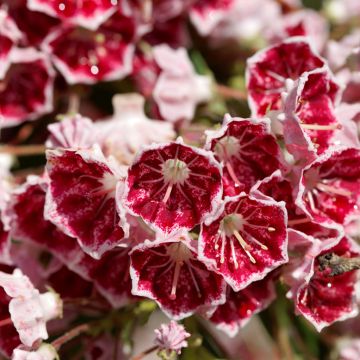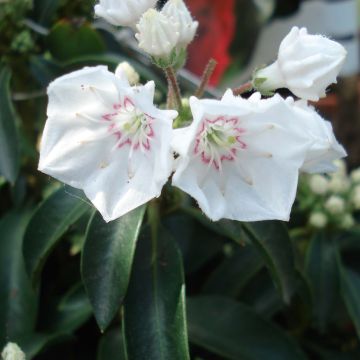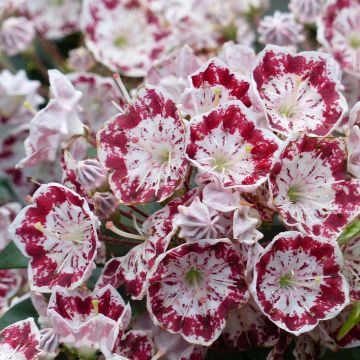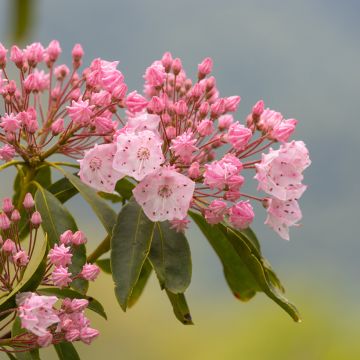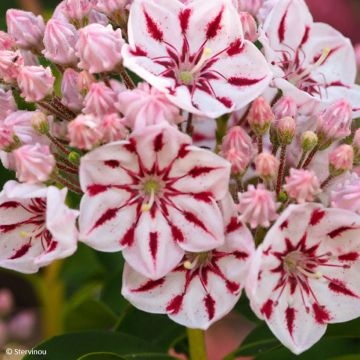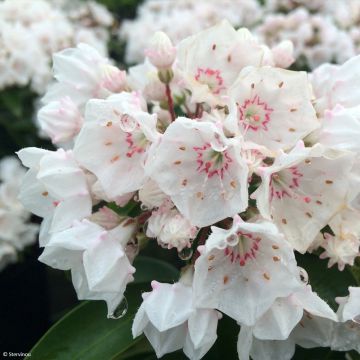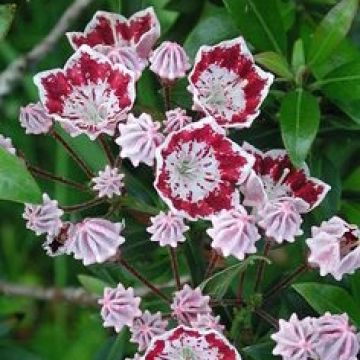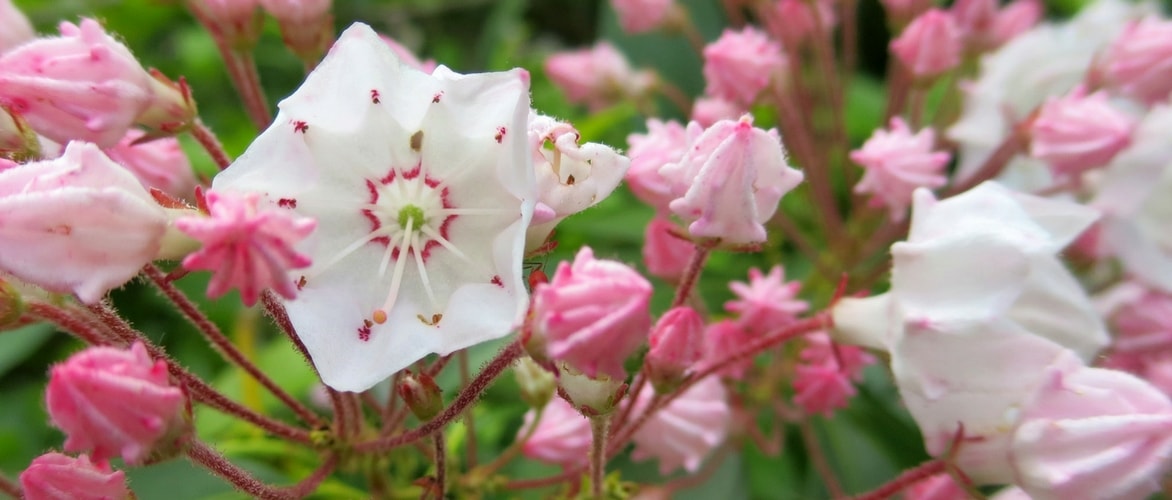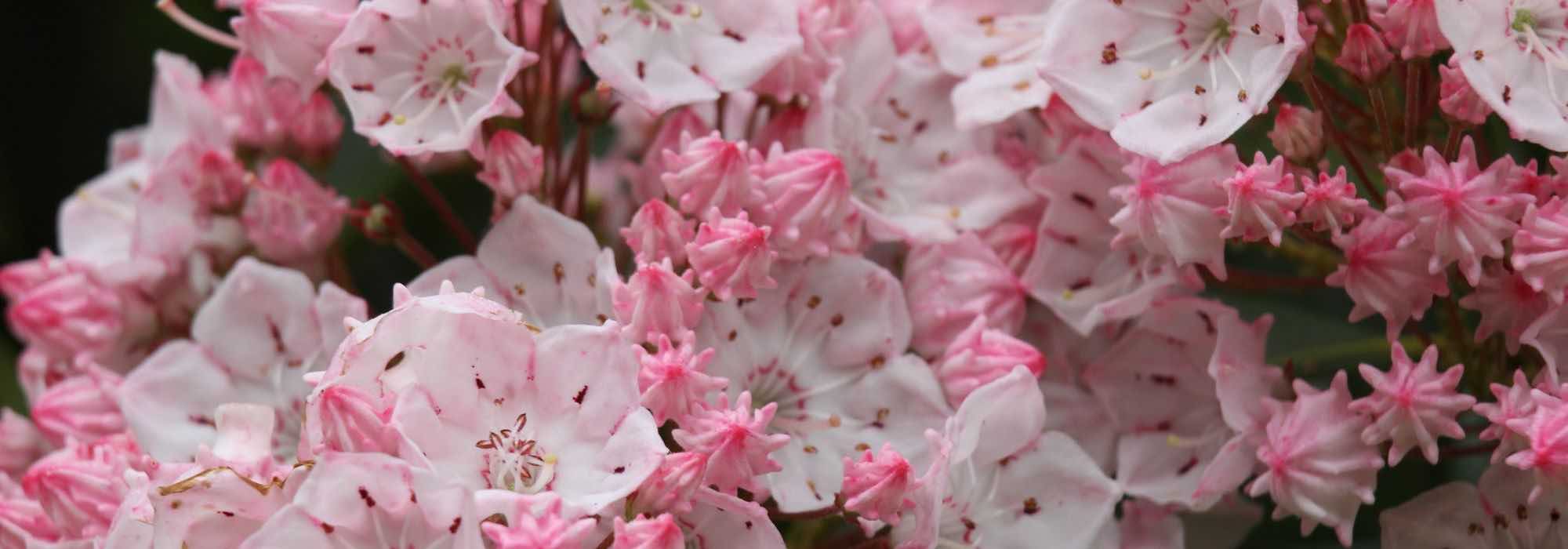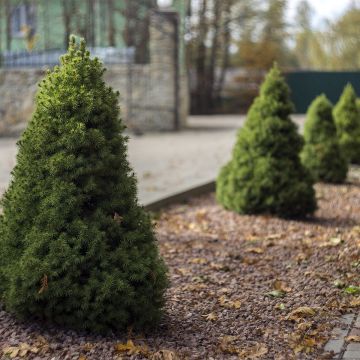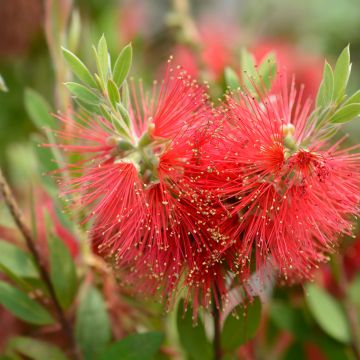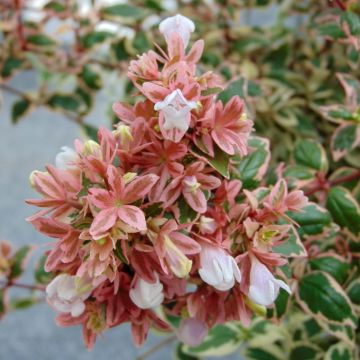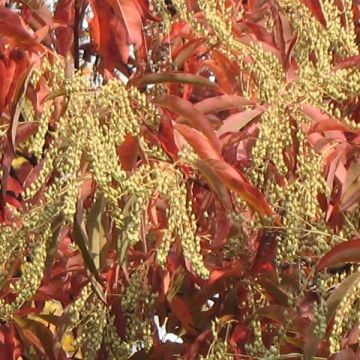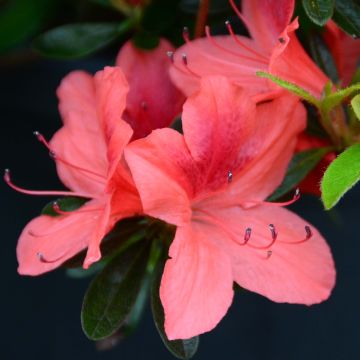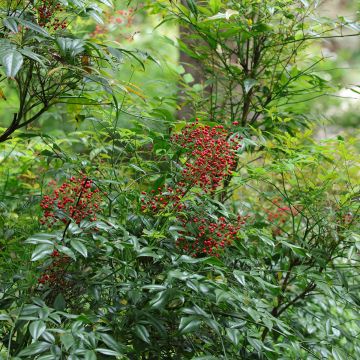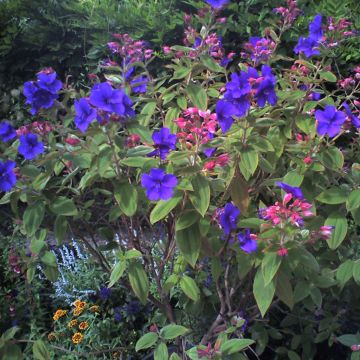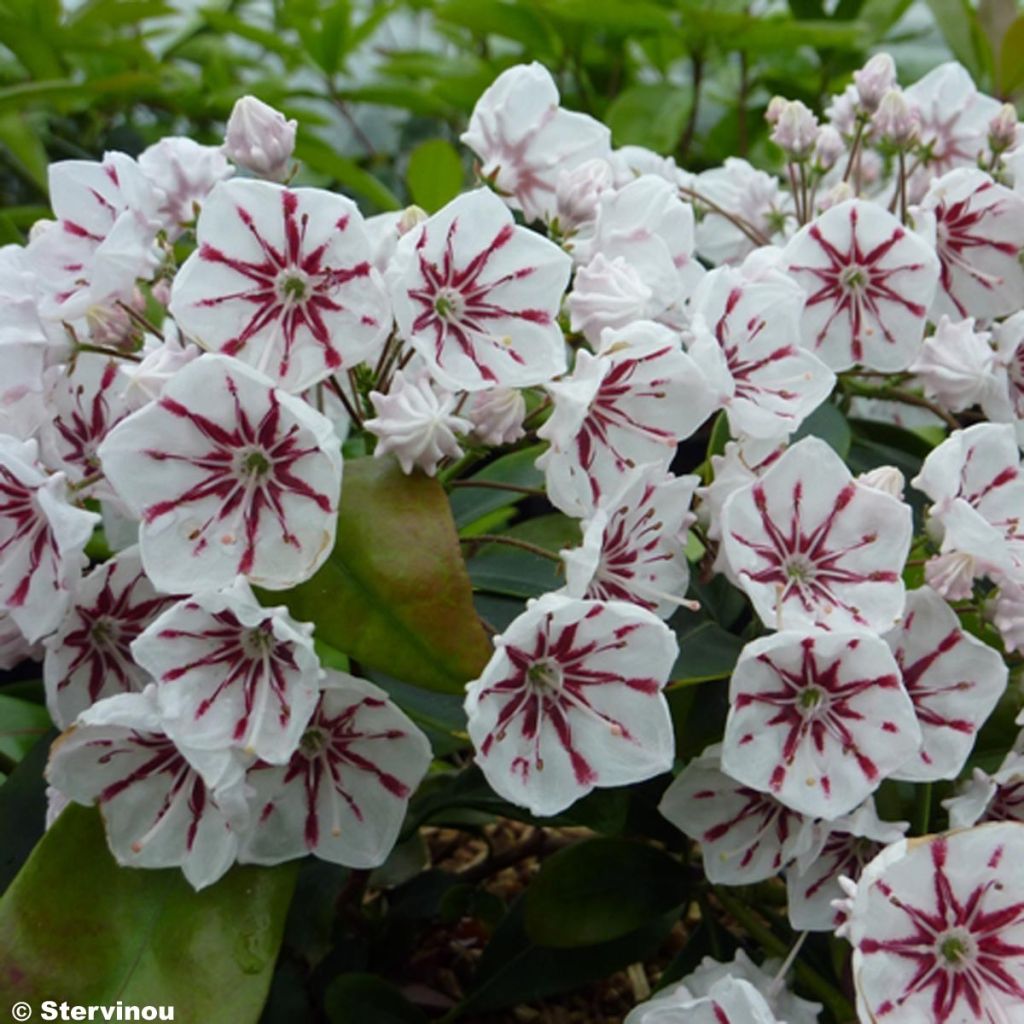

Kalmia latifolia Peppermint - Mountain Laurel
Kalmia latifolia Peppermint - Mountain Laurel
Kalmia latifolia Peppermint
Mountain Laurel, Calico Bush, Spoonwood, American Mountain Laurel, Broad-leaved Kalmia
The plant is beautiful but despite the fast delivery, the box arrived broken and the plants had many broken branches. I thought they should be better protected as it's not the first time this has happened to me.
Cec, 29/10/2024
Special offer!
Receive a €20 voucher for any order over €90 (excluding delivery costs, credit notes, and plastic-free options)!
1- Add your favorite plants to your cart.
2- Once you have reached €90, confirm your order (you can even choose the delivery date!).
3- As soon as your order is shipped, you will receive an email containing your voucher code, valid for 3 months (90 days).
Your voucher is unique and can only be used once, for any order with a minimum value of €20, excluding delivery costs.
Can be combined with other current offers, non-divisible and non-refundable.
Why not try an alternative variety in stock?
View all →This plant carries a 24 months recovery warranty
More information
We guarantee the quality of our plants for a full growing cycle, and will replace at our expense any plant that fails to recover under normal climatic and planting conditions.
Would this plant suit my garden?
Set up your Plantfit profile →
Description
Kalmia latifolia Peppermint, also known as Mountain Laurel, is a large, dense, evergreen bush with a somewhat rounded and heavily branched habit. It stands out for its abundant flowers which have fresh and spicy perfume like a good English mint sweet. The flowers, grouped in large corymbs, evoke clusters of pale pink seashells, marked by radiating bands and red spots. It is also attractive for its pointed and evergreen foliage that is has coppery bronze tones in spring. This shrub requires a rich and very acidic soil to look its best.
Kalmia latifolia, native to the mountains of eastern North America, and also named Mountain Laurel or American Laurel, belongs to the Ericaceae family, like Heather and Rhododendron. This broad-leaved Peppermint Kalmia is a vigorous evergreen bush, reaching 1.5 meters (4 feet 11 inches) in all directions, and is slow growing. The adult size is reached in ten years, its longevity exceeds 50 years. Its well-branched trunk, gives it a bushy, thick and somewhat erect habit. Its evergreen foliage is bronze in spring, and then becomes shiny and dark green. It is composed of small glossy pointed leaves, tough and thick, alternate and lanceolate. These are very decorative and provide all year round interest. The plant looks its best in early summer, due to its very spectacular flowering. In May-June, it is completely covered with flowers with unique markings. Each branch carries clusters (corymbs) of small pinkish white flowers, in the form of 5-sided, very flared, campanulate corollas, 2 to 2.5 cm (0.8 to 1 in) in diameter. The centre of the flower is patterned with fine dark red lines radiating out to the edge of the petals with spots of the same colour. Each flower carries 10 purple stamens within the petals. The flowers do not bloom all at once. The corymbs present amazing contrasts between the not yet bloomed floral buds which are very veined and surprisingly architectural, and the already opened pale pink flowers. After flowering, if they have not fallen, the flowers give way to brown capsule fruits that last throughout winter. Its has unusual grey and grooved bark.
Kalmias are unjustly unknown. Their flowering is enchanting, they are particularly hardy heathland shrubs that should be planted in semi-shade, in a moist and humus-rich soil. Unique, very decorative and rare, Kalmia Peppermint will work beautifully in the garden, where it will highlight all the surrounding plants! There are many ways of using this plant in the garden. It will be the ideal companion for heathland plants (Rhododendrons, Azaleas, Camellias, Heathers, Hydrangeas, Japanese Maples, Magnolias, Andromedas, Cyclamen...). It will work well in an informal hedge, in mixed shrub planting, added to a perennial bed, around a pond or even as a specimen plant. Its small size also means that it works well in containers on balconies or patios, provided the soil is always kept moist.
Properties:
Kalmia latifolia is a shrub which is entirely toxic to humans as well as for animals (dogs, cats, sheep, horses) when eaten, including its leaves, flowers, fruits and roots.
However, it is used in homeopathy for pain relief. In the past, its very hard wood was used to make many utility objects, including wooden spoons, hence its English nickname of Spoonwood.
Anecdote:
The denomination of the genus Kalmia, was chosen by Carl von Linne, in tribute to Pehr Kalm, famous Swedish botanist, who was one of the first to explore the flora in some parts of North America from 1747 to 1751.
The flower of the Kalmia latifolia is the emblem of the States of Connecticut and Pennsylvania.
Kalmia latifolia Peppermint - Mountain Laurel in pictures
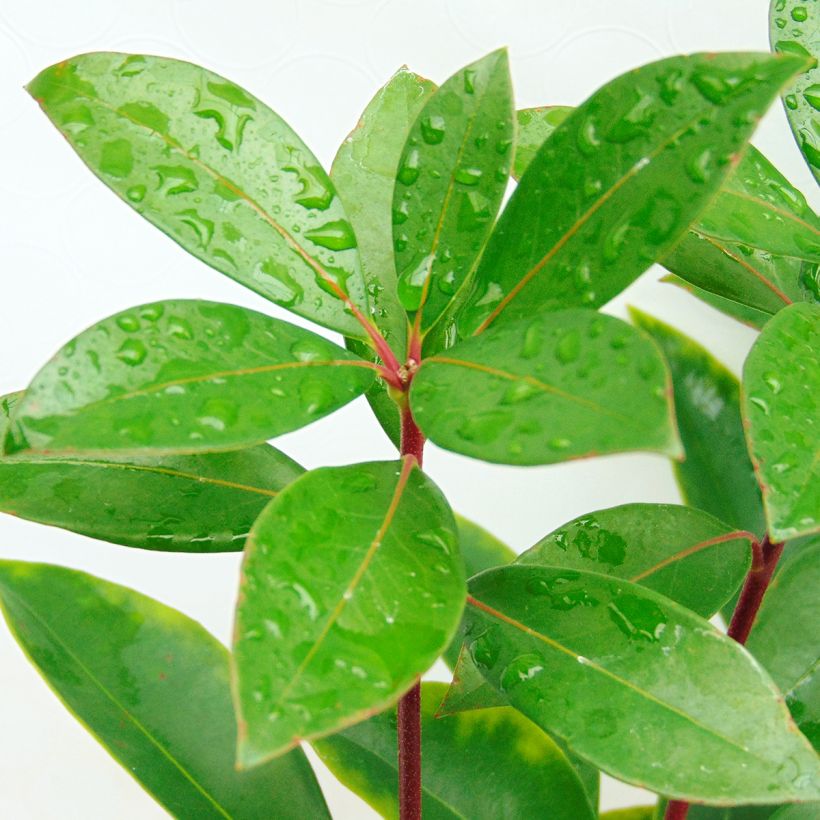

Plant habit
Flowering
Foliage
Botanical data
Kalmia
latifolia
Peppermint
Ericaceae
Mountain Laurel, Calico Bush, Spoonwood, American Mountain Laurel, Broad-leaved Kalmia
North America
Planting and care
Native to the mountains of Eastern North America, Kalmia latifolia Peppermint is extremely hardy and can withstand very low temperatures, below -20°C (-4 °F). Belonging to the Ericaceae family, it requires a semi-shaded position, in a humus-rich and fertile, highly acidic, damp soil whch is also well-drained. Waterlogged ground will certainly make it disappear. Plant in spring or autumn, avoiding periods of frost or high temperatures. Prepare a wide and deep pit, 40 cm (15.7 in) by 40 cm (15.7 in). Regular watering during the first few weeks after planting is necessary to keep the soil moist and cool. A mulch at the base of the plant can be beneficial to protect the fine and superficial roots. Each spring, scratch the soil around the base of the plant and top with compost, ericiaceous soil and mulch. If the soil is calcareous, it will need to be replaced with a mixture of ericaceous soil and leaf compost. The Mountain Laurel can tolerate sunny exposure, but dislikes direct, scorching sunlinght. It must be positioned in the shade during the hottest hours of the day, and mulch the base of the plant in order to preserve the misture in the soil. During the summer period and especially in case of drought, regular watering (preferably with rain water) will be essential. This summer watering is particularly important when the flower buds form for the following spring. Loving coolness and high humidity, the mountain laurel will be thrive in a coastal or rainy climate. Its small size means it is well adapted to be grown in a pot on a patio or balcony but use a large pot and water well to avoid the soil from drying out. Apart from the removal of faded flowers, the pruning of the Kalmia latifolia is almost unnecessary and can hinder the flowering of the next year as the flower buds form at the ends of the branches. It is possible, however, to remove the dead wood and slightly prune to maintain the balanced habit of the dwarf Kalmia.
Planting period
Intended location
Care
Planting & care advice
-
, onOrder confirmed
Reply from on Promesse de fleurs
Similar products
Haven't found what you were looking for?
Hardiness is the lowest winter temperature a plant can endure without suffering serious damage or even dying. However, hardiness is affected by location (a sheltered area, such as a patio), protection (winter cover) and soil type (hardiness is improved by well-drained soil).

Photo Sharing Terms & Conditions
In order to encourage gardeners to interact and share their experiences, Promesse de fleurs offers various media enabling content to be uploaded onto its Site - in particular via the ‘Photo sharing’ module.
The User agrees to refrain from:
- Posting any content that is illegal, prejudicial, insulting, racist, inciteful to hatred, revisionist, contrary to public decency, that infringes on privacy or on the privacy rights of third parties, in particular the publicity rights of persons and goods, intellectual property rights, or the right to privacy.
- Submitting content on behalf of a third party;
- Impersonate the identity of a third party and/or publish any personal information about a third party;
In general, the User undertakes to refrain from any unethical behaviour.
All Content (in particular text, comments, files, images, photos, videos, creative works, etc.), which may be subject to property or intellectual property rights, image or other private rights, shall remain the property of the User, subject to the limited rights granted by the terms of the licence granted by Promesse de fleurs as stated below. Users are at liberty to publish or not to publish such Content on the Site, notably via the ‘Photo Sharing’ facility, and accept that this Content shall be made public and freely accessible, notably on the Internet.
Users further acknowledge, undertake to have ,and guarantee that they hold all necessary rights and permissions to publish such material on the Site, in particular with regard to the legislation in force pertaining to any privacy, property, intellectual property, image, or contractual rights, or rights of any other nature. By publishing such Content on the Site, Users acknowledge accepting full liability as publishers of the Content within the meaning of the law, and grant Promesse de fleurs, free of charge, an inclusive, worldwide licence for the said Content for the entire duration of its publication, including all reproduction, representation, up/downloading, displaying, performing, transmission, and storage rights.
Users also grant permission for their name to be linked to the Content and accept that this link may not always be made available.
By engaging in posting material, Users consent to their Content becoming automatically accessible on the Internet, in particular on other sites and/or blogs and/or web pages of the Promesse de fleurs site, including in particular social pages and the Promesse de fleurs catalogue.
Users may secure the removal of entrusted content free of charge by issuing a simple request via our contact form.
The flowering period indicated on our website applies to countries and regions located in USDA zone 8 (France, the United Kingdom, Ireland, the Netherlands, etc.)
It will vary according to where you live:
- In zones 9 to 10 (Italy, Spain, Greece, etc.), flowering will occur about 2 to 4 weeks earlier.
- In zones 6 to 7 (Germany, Poland, Slovenia, and lower mountainous regions), flowering will be delayed by 2 to 3 weeks.
- In zone 5 (Central Europe, Scandinavia), blooming will be delayed by 3 to 5 weeks.
In temperate climates, pruning of spring-flowering shrubs (forsythia, spireas, etc.) should be done just after flowering.
Pruning of summer-flowering shrubs (Indian Lilac, Perovskia, etc.) can be done in winter or spring.
In cold regions as well as with frost-sensitive plants, avoid pruning too early when severe frosts may still occur.
The planting period indicated on our website applies to countries and regions located in USDA zone 8 (France, United Kingdom, Ireland, Netherlands).
It will vary according to where you live:
- In Mediterranean zones (Marseille, Madrid, Milan, etc.), autumn and winter are the best planting periods.
- In continental zones (Strasbourg, Munich, Vienna, etc.), delay planting by 2 to 3 weeks in spring and bring it forward by 2 to 4 weeks in autumn.
- In mountainous regions (the Alps, Pyrenees, Carpathians, etc.), it is best to plant in late spring (May-June) or late summer (August-September).
The harvesting period indicated on our website applies to countries and regions in USDA zone 8 (France, England, Ireland, the Netherlands).
In colder areas (Scandinavia, Poland, Austria...) fruit and vegetable harvests are likely to be delayed by 3-4 weeks.
In warmer areas (Italy, Spain, Greece, etc.), harvesting will probably take place earlier, depending on weather conditions.
The sowing periods indicated on our website apply to countries and regions within USDA Zone 8 (France, UK, Ireland, Netherlands).
In colder areas (Scandinavia, Poland, Austria...), delay any outdoor sowing by 3-4 weeks, or sow under glass.
In warmer climes (Italy, Spain, Greece, etc.), bring outdoor sowing forward by a few weeks.






























